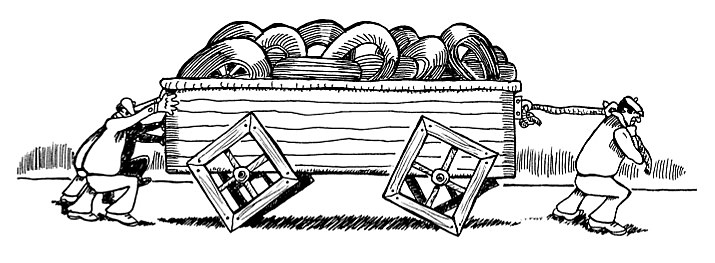Digitalization does not happen on its own
When it comes to digital transformation, the most critical task is to transform the corporate culture and employee habits. Here at Mikrocop we had a chance to experience that first hand when we were digitizing our own operations.

© Performance Management Company, 2014
The implementation of the new information solution and digitization of business processes are huge challenges to address, in particular if we want to change the habits of people, train them, motivate them to embrace change, and raise their digital competency level.
Progress in this area is hindered by unclear expectations about what changes digital transformation will bring and what benefits it will render, which further strengthens the importance of having a clear business process digitization strategy and objectives.
Change priorities
- Quality, responsiveness
- Transparency
- Efficiency
- Compliance, security
Digitization of business processes
Mikrocop started its operations on paper and microfilms, using different systems for storing documents and data. The first major change the company had to undergo was the digitization of business processes and implementation of a process management system, which meant that we stopped creating internal documentation on paper. Certain processes were rendered completely paperless and the outputs were stored in electronic format.
Our approach to process digitization was carefully planned and gradual, with a clearly defined purpose and objectives. Besides improving the efficiency of operations, we are also striving to secure a real-time overview of the status of individual processes, thereby being able to base our business decisions on real-time data.
– Simona Kogovšek, Director of Mikrocop
Electronic documents were previsouly stored in systems, shared folders, PCs and disks, and shared by electronic mail or shared folders. Eventually, this type of document management led to many problems, such as disposition of documents after the expiry of their retention periods, accessibility of documents, user access rights.
Moreover, it was extremely hard to ensure protection of personal data, in particular when e-mailing documents that contained personal data and when erasing personal data for which no basis for storage existed from the Inbox of employees.
Multi-level digitization
The digitalization process ran on several levels. First we put a lid on generation of paper documents inside the company. Paper documents were halted when entering the company. We began with incoming invoices, which make up for most of inbound mail. The next step was setting up an electronic storage system for archiving paper-based documents and those already created in electronic format, and establishing connections with other information systems.
- We implement our services and solutions in our company before offering them to clients.
The digitalization process ran on several levels. First we put a lid on generation of paper documents inside the company. Paper documents were halted when entering the company. We began with incoming invoices, which make up for most of inbound mail. The next step was setting up an electronic storage system, for archiving paper-based documents and those already created in electronic format, and establishing connections with other information systems.
Gradually, we resolved the existing situation as regards paper documents and documents on microfilms and CDs kept in the physical archive, offices and drawers. The latter were digitized or preserved in original format until the expiry of their retention periods.
The recipe for a successful digital transformation seems very simple: capture incoming documents and data in the shortest time possible, provide digital support for business processes, and connect them with other information systems while actively supporting and motivating employees to adapt their behavior.
– Simona Kogovšek, Director of Mikrocop
We are still aiming to optimize document and data storage across systems by purpose, be it the document system or a dedicated project management tool. We are monitoring the needs of specific business areas and looking for the most appropriate tools available. We utilize the capabilities of our own InDoc EDGE data management platform to serve as the document management system, business process management system, and electronic data storage system.
Information is just a click away
Every digitalization project is complex. It must be based on a clear digitization strategy with defined goals and scope. To do this, we need to know well the existing situation, and taken into account the requirements of specific business areas and the legislation when planning the activities. Digitization definitely brings changes to different operation levels but it is also an opportunity for its optimization and regulation./p>
- The hardest task is to change the culture and habits.
Time savings are difficult to pinpoint. However, we can say with certainty that we have greatly simplified the handling of once paper-based documents. With information just a click away, we can now prepare certain data much more easily and quickly, saving up the time we used to spend searching for a specific document in various binders and folders.
In key business processes that generated the majority of documents, paper was fully ousted. Accounting, for example, is now completely paperless. Data is no longer stored on paper and filing cabinets have become obsolete.
– Simona Kogovšek, Director of Mikrocop
Elaborate strategy and clear goals
Any implementation of change brings with it the risk of mistakes, and we have made our share of those on our digital journey.
The main obstacle Mikrocop had to overcome while digitizing its own operations was the fact that its project team was already overworked dealing with its daily tasks. Soon we realized that in order to successfully complete our internal digital transformation we had to free our team to focus its time and attention on the project. It was crucial for the team to believe in the benefits that digitization would bring them personally, their colleagues, and the company.
The second mistake we made was when we set the structure of documents. Initially, we wanted the document structure to reflect the company’s then relevant organizational chart.
- Complex as they are and depending on the engagement of all employees, digitization projects require an elaborate strategy and clear goals.
While reorganizing and merging two functions into one a problem arose. We found that it made more sense to structure documents by corporate functions that correspond to all classification plans and ISO standard chapters rather than following the current area-based organization structure. Document structure should enable the allocation of rights on individual folders.
Our rather naive expectations that after we had defined the strategy and made certain business decisions, the company’s digitization would simply run by itself were incorrect. It turned out very quickly that we could not achieve the goal along with other regular and project commitments so we designed a special digitalization team and appointed a responsible person.
– Simona Kogovšek, Director of Mikrocop
Digitization guidelines
- Set up a competent team
Digitization requires a professional, and competent team that has corporate, legal and technical expertise which they will devote 100% to the project.
- Encourage, motivate, educate
Show your employees the benefits and advantages of a different way of working and using new technologies so they will be able to see for themselves the benefits brought about by change. Motivate them to become the ambassadors of digitalization.
- Run it in stages
Break down your digital transformation project into manageable stages. Start with simple business processes that are wasting everyone’s time and then move on to optimize and digitize the company's key business processes.
- Set priorities
Focus on activities that are normally hard and prioritize execution accordingly.
- Live the change
After completing the project, monitor the functioning and changing business needs, regularly amend the document structure, and support users.
Want to know more? Contact us!



